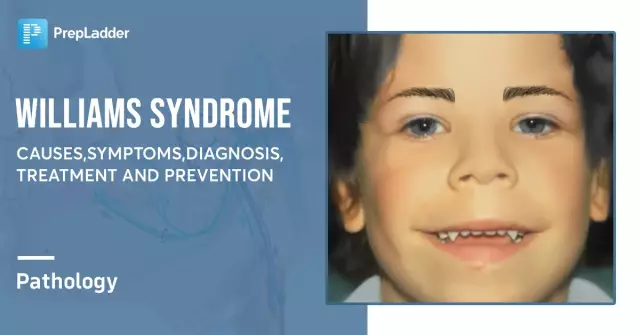- Author Rachel Wainwright [email protected].
- Public 2023-12-15 07:39.
- Last modified 2025-11-02 20:14.
Reye's syndrome

A rather rare and very life-threatening condition characterized by the development of fatty liver infiltration and rapidly progressive encephalopathy is called Reye's or Reye's syndrome.
This condition occurs in children and adolescents, often at the age of 4 to 12 years, against the background of treatment of measles, influenza, chickenpox and other fevers of viral origin with drugs that contain acetylsalicylic acid (aspirin). According to statistics, only a few cases have been recorded when Reye's syndrome was detected in an adult.
The condition is accompanied by such manifestations as:
- Hyperammone;
- More than threefold increase in serum levels of aspartate aminotransferase and alanine aminotransferase.
It is noteworthy that with these manifestations, the level of bilirubin in the patient's blood remains normal. The condition is based on generalized damage to mitochondria, which leads to a violation of b-oxidation of fatty acids and inhibition of oxidative phosphorylation.
The syndrome was first described in 1963 by the Australian pathologist Ralph Douglas Kenneth Reye. The physician, then director of the hospital's pathology department, found that 17 of the 21 infant deaths were fatal to encephalopathy and fatty degeneration of internal organs, which would later be named Reye's syndrome in his honor.
Consequences of the condition can include brain damage, lethargy, seizure disorders, mental retardation, damage to peripheral nerves, and muscle twitching. In medical practice, cases have been reported when Reye's syndrome occurred in the same child twice.
Reye's syndrome: pathogenesis
Nowadays, the pathogenesis of Reye's syndrome remains unclear, however, a clear relationship has been revealed between the intake of drugs containing acetylsalicylic acid in patients with fever of viral origin.
Research conducted in 1980 in the United States showed that child mortality due to Reye's syndrome dropped significantly when the government decided to inform the public about the harmful effects of acetylsalicylic acid used during viral infections in children. Thus, it was possible to significantly reduce the incidence of the condition and mortality among children, after 17 years in 1997, only 2 cases of the syndrome were recorded.
There is evidence that the pathogenesis of Reye's syndrome in some cases was associated with the transfer of the syndrome by a blood relative. Until the end, this tendency has not been investigated, it is assumed that it is associated with heredity, or the condition can be transmitted from one relative to another.
Reye's syndrome symptoms
Clinical manifestations vary depending on the severity of the syndrome. Usually on the fifth or sixth day of a viral disease, and in case of chickenpox - on the fourth after the onset of rashes, the child suddenly develops nausea and uncontrollable vomiting, due to a history of ASA-containing drugs.
These symptoms of Reye's syndrome are accompanied by changes in the child's mental status, ranging from mild lethargy and psychomotor agitation to episodes of complete disorientation and deep coma.
The main symptoms of Reye's syndrome in children under 3 years of age are:
- Breathing disorders;
- Increased fatigue and drowsiness;
- Increase in serum aspartate aminotransferase, ammonia and alanine aminotransferase;
- Convulsions.
The lack of timely treatment of the condition leads to the rapid development of coma, respiratory arrest, convulsions, decortication and decebration postures.
In 40% of reported cases, sick children had an enlarged liver, rarely accompanied by jaundice.
Prevention of Reye's syndrome
A necessary measure for the prevention of the condition in children and adolescents is the careful use of ASA-containing drugs in the presence of a high temperature. It is better in a similar situation to replace acetylsalicylic acid with Ibuprofen or Paracetamol.
Reye's syndrome diagnosis
Reye's syndrome is suspected by a doctor when, for no obvious reason, a child has vomiting and nausea, and there are signs of sudden development of cerebral edema. For a reliable diagnosis of the condition, the doctor needs to carry out a lumbar puncture and a biopsy of the patient's liver.
Reye's syndrome: treatment
It is most important to quickly get the child to the intensive care unit, since respiratory arrest can occur, which requires mechanical ventilation to prevent it. To treat Reye's syndrome, the doctor needs to have an accurate history of the patient and his family to rule out congenital metabolic disorders.

In view of the fact that no treatment can stop the development of the syndrome, early diagnosis of the condition and intensive therapy aimed at maintaining the vital functions of the body play the most important role.
To prevent bleeding, electrolytes, fluids, vitamin K and glucose are administered intravenously to the patient. Glycerin, corticosteroids, and mannitol are used to reduce intracranial pressure. The liquid is prescribed in small quantities, since against the background of developing cerebral edema, it can play a fatal role.
This is followed by intubation of the trachea so that the child can breathe, hyperventilation to measure intracerebral pressure, and an active fight against cerebral edema. In the treatment of Reye's syndrome, in certain cases, to control blood pressure and blood gases, it is necessary to insert catheters into the veins and arteries.
Reye's syndrome is a condition in which encephalopathy and fatty liver infiltration rapidly progresses, while taking acetylsalicylic acid in the treatment of viral fevers in children and adolescents.
YouTube video related to the article:
The information is generalized and provided for informational purposes only. At the first sign of illness, see your doctor. Self-medication is hazardous to health!






